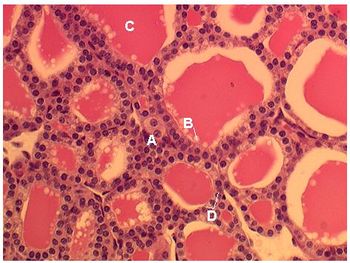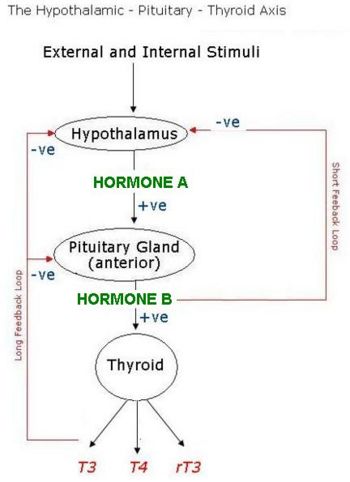Difference between revisions of "Thyroid Gland Flash Cards - Anatomy & Physiology"
m (New page: {{toplink |backcolour = FAFAD2 |linkpage =Endocrine System - Anatomy & Physiology |linktext =Endocrine System |maplink = Endocrine System (Content Map) - Anatomy & Physiology |pagetype =An...) |
m |
||
| (9 intermediate revisions by 3 users not shown) | |||
| Line 1: | Line 1: | ||
| − | + | <FlashCard questions="10"> | |
| − | | | + | |q1=Describe embryological origin of the Thyroid Gland. |
| − | | | + | |a1=The thyroid gland is a downgrowth from the pharyngeal endoderm of the developing tongue. |
| − | | | + | |l1=Thyroid Gland - Anatomy & Physiology |
| − | | | + | |q2=Describe the location of the thyroid gland, it's closely associated structures and anatomical landmarks. |
| − | | | + | |a2= |
| − | | | + | *The thyroid gland is adjacent to the cranial part of the trachea, closely associated with the Parathyroid Glands which may be within or close to the thyroid gland itself. |
| − | | | + | *Close to the thyroid gland are the ''Sternohyoid'' and ''Sternothyroid'' muscles, the ''recurrent laryngeal'' nerve and the ''carotid sheath''. |
| − | | | + | |l2=Thyroid Gland - Anatomy & Physiology |
| − | | | + | |q3=Describe the blood supply and venous drainage of the Thyroid Gland. |
| − | + | |a3= | |
| − | < | + | *Supply: Cranial Thyroid Artery and Caudal Thyroid Artery |
| + | *Venous Drainage: Thyroid Vein (leading to Internal Jugular Vein). | ||
| + | |l3=Thyroid Gland - Anatomy & Physiology | ||
| + | |q4=The Thyroid gland consists of various sized follicles. What is the name of the cells which line the lumen of the follicles, and what is their function? | ||
| + | |a4=Follicular Cells - these synthesize thyroglobulin in their golgi apparatus. Thyroglobulin is a glycoprotein consisting of 70 linked ''tyrosine'' molecules and is the source of thyroid hormones. | ||
| + | |l4=Thyroid Gland - Anatomy & Physiology | ||
| + | |q5=Label the following histological section: (Image 1 below) | ||
| + | |a5= | ||
| + | *A - Connective Tissue Capsule | ||
| + | *B - Thyroid Follicles | ||
| + | *C - Connective Tissue Septum | ||
| + | *D - Blood Vessels in Capsule. | ||
| + | |l5=Thyroid Gland - Anatomy & Physiology#Histology Gallery | ||
| + | |q6=Which Letter represents the location of the C-Cells of the Thyroid Gland, and what is their function in 'Image 1' below? | ||
| + | |a6= | ||
| + | *A represents the C Cells. | ||
| + | *The C-Cells (aka Parafollicular Cells) produce Calcitonin, a hormone which acts to lower the plasma calcium level. | ||
| + | |l6=Thyroid Gland - Anatomy & Physiology#Ultrastructure and Histology | ||
| + | |q7=Define and describe the process of ''Iodide Trapping''. | ||
| + | |a7= | ||
| + | *Iodide trapping is the process by which Iodide molecules (I-) are concentrated in the colloid at a level up to 250x greater than the plasma level. | ||
| + | *The Na+/I- symport in the basal membrane of the follicular cells moves the iodine from the plasma, into the cell. From here it is transported into the colloid. | ||
| + | *The follicular cells and the pumps function in response to Thyroid Stimulating Hormone from the Pituitary Gland. | ||
| + | |l7=Thyroid Gland - Anatomy & Physiology#Iodine Uptake | ||
| + | |q8=Name the three hormones produced in the thyroid gland and describe how they are transported around the body? | ||
| + | |a8= | ||
| + | *Hormones: Triiodothyronine (T3), Thyroxine (T4) and Reverse T3. | ||
| + | *Thyroid hormones are lipid soluble, thus require a binding protein in order to travel in the bloodstream. Thyroid Binding Globulin caries 70-80% of the circulating hormone, with Thyroxine Binding Pre-Albumin, and Albumin carrying the remainder. | ||
| + | |l8=Thyroid Gland - Anatomy & Physiology#Transport | ||
| + | |q9=What are Hormone A and Hormone B in this schematic diagram ('Image 2' below) of the Hypothalamic - Pituitary - Thyroid Axis: | ||
| + | |a9= | ||
| + | *Hormone A: TRH - Thyrotropin Releasing Hormone | ||
| + | *Hormone B: TSH - Thyroid Stimulating Hormone (Thyrotropin) | ||
| + | |l9=Thyroid Gland - Anatomy & Physiology#Regulation | ||
| + | |q10=Decribe the effects that T3 and T4 have on the following systems/physiological mechanisms: | ||
| + | |a10= | ||
| + | *Musculoskeletal System | ||
| + | *Carbohydrate metabolism | ||
| + | *Fat metabolism | ||
| + | *Basal Metabolic Rate | ||
| + | *Cardiovascular System | ||
| + | *Nervous System | ||
| + | *Alimentary System | ||
| + | *Musculoskeletal system - Thyroid hormone promotes bone growth | ||
| + | *Carbohydrate metabolism - Thyroid hormone stimulates glucose uptake, glycolysis, gluconeogenesis | ||
| + | *Fat metabolism - Thyroid hormone mobilises lipids from adipose stores. Accelerates oxidation of lipids to produce energy (occurs within mitochondria). Increases size and number of mitochondria. | ||
| + | *Basal Metabolic Rate (BMR) - Thyroid hormone causes and increase in BMR in all tissues except brain, spleen, gonads. Results in increased heat production, increased oxygen consumption. | ||
| + | *Cardiovascular actions - Thyroid hormone increases Cardiac output, heart rate and contractility. | ||
| + | *Nervous system - thyroid hormones are required for development of this system. They also enhance the sympathetic nervous system (by increasing epinephrine receptors). | ||
| + | *Alimentary System - Thyroid hormone increases appetite and feed intake, increases secretion of pancreatic enzymes and increases motility. | ||
| + | |l10=Thyroid Gland - Anatomy & Physiology#Thyroid Hormone Actions | ||
| + | </FlashCard> | ||
| + | {| | ||
| + | |Image 1 | ||
| + | |[[Image:ThyroidGlandFlashCard.jpg|350px|©RVC 2008]] | ||
| + | |||
| + | |- | ||
| + | |Image 2 | ||
| + | |[[Image:ThyroidGlandFlashCard3.jpg|350px]] | ||
| + | |} | ||
| + | |||
| + | |||
| + | [[Category:Endocrine System - Anatomy & Physiology]] | ||
| + | [[Category:Endocrine System Anatomy & Physiology Flashcards]] | ||
Latest revision as of 12:22, 21 June 2011
| Question | Answer | Article | |
| Describe embryological origin of the Thyroid Gland. | The thyroid gland is a downgrowth from the pharyngeal endoderm of the developing tongue.
|
Link to Article | |
| Describe the location of the thyroid gland, it's closely associated structures and anatomical landmarks. |
|
Link to Article | |
| Describe the blood supply and venous drainage of the Thyroid Gland. |
|
Link to Article | |
| The Thyroid gland consists of various sized follicles. What is the name of the cells which line the lumen of the follicles, and what is their function? | Follicular Cells - these synthesize thyroglobulin in their golgi apparatus. Thyroglobulin is a glycoprotein consisting of 70 linked tyrosine molecules and is the source of thyroid hormones.
|
Link to Article | |
| Label the following histological section: (Image 1 below) |
|
Link to Article | |
| Which Letter represents the location of the C-Cells of the Thyroid Gland, and what is their function in 'Image 1' below? |
|
Link to Article | |
| Define and describe the process of Iodide Trapping. |
|
Link to Article | |
| Name the three hormones produced in the thyroid gland and describe how they are transported around the body? |
|
Link to Article | |
| What are Hormone A and Hormone B in this schematic diagram ('Image 2' below) of the Hypothalamic - Pituitary - Thyroid Axis: |
|
Link to Article | |
| Decribe the effects that T3 and T4 have on the following systems/physiological mechanisms: |
|
Link to Article | |
| Image 1 | 
|
| Image 2 | 
|